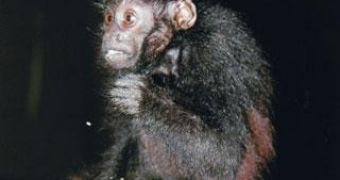In the 21th century, when we thought that all that is larger than a mouse has already been described by zoologists, the surprises keep coming. A new species of uakari monkey has been described in the International Journal of Primatology. Its discoverer is the New Zealand primatologist Jean-Phillipe Boubli of the University of Auckland, who encountered the animal after following Yanomamo Indians on their hunt trips along the Rio Arac?, a tributary of the Rio Negro (Brazil).
"They told us about this black uakari monkey, which was slightly different to the one we knew from Pico de Neblina National Park, where I'd worked earlier. I searched for that monkey for at least five years. The reason I couldn't find it was because the place where they were was sort of unexpected," Boubli told National Geographic News.
Other uakaris live in the Amazons and its tributaries' banks, in forests flooded during the rainy season, but this species inhabits a mountainous area on the Brazil-Venezuela border, far away from the other uakaris.
"There is another species of primate in that region which is very similar to the uakari. The two compete ecologically, so wherever that monkey occurs, you don't expect to find uakaris. That's why I wasn't really looking in those places," said Boubli. The new monkey was baptized Cacajao ayresii, in the honor of the Brazilian biologist Jos? M?rcio Ayres, died in 2003, former member of the Wildlife Conservation Society, who founded a protected area in the heart of the Amazon.
"But the newfound Ayres uakari appears confined to a very small area outside any preserve and is hunted by locals. We're going to have to create a park or reserve, because [its habitat is] not a protected area. The population is quite small, so they are quite vulnerable," said Boubli.
All is known by now about the new species is that it forms social groups and could be a seed-eater, just like other uakaris, but Boubli's team will investigate its biology.
"It's very important to define what those monkeys are doing there, how big their range is, because we want to make a case for the Brazilian government to create a reserve. Finding a relatively large monkey as a new species these days is pretty cool. It shows how little we really know about the biodiversity of the Amazon," said Boubli.
"Many of these tropical forests are being destroyed now. There's a desperate need to save these animals, but we really need to know what animals we're trying to save [and] where they live," said Anthony Rylands, a primatologist at Conservation International.
"Today more new primate species are being described in the wake of advances in DNA technology. The sophistication of genetic analysis from just about any material-hair, feces-means we're able to get a much more precise view of primate diversity. Some of them, especially the nocturnal ones, are really quite cryptic-you can never recognize the differences simply by looking. We've suddenly begun to realize that animals we previously considered to be one species are completely different creatures," added Rylands.
Boubli had already discovered a new species of bearded saki monkey (Chiropotes) in 2003, and new species of spider monkeys, squirrel monkeys, and capuchin monkeys could be confirmed by DNA analysis.
"If we are still finding monkeys, imagine how many invertebrates and things like that are still out there," said Boubli.

 14 DAY TRIAL //
14 DAY TRIAL //